 |

Project
Management MGMT627
VU
LESSON
07
THE
PROJECT MANAGER
(CONTD.)
Broad
Contents
Successful
Project Manager
Role
of Project Manager
Project
Champions
Project
Manager's Power/
Authority
Functional
and Project
Organizations
7.1
Successful
Project Manager:
A
good project management
methodology provides a framework
with repeatable processes,
guidelines,
and techniques to greatly increase the
odds of success, and therefore,
provides value
to
the project and the Project Manager.
However, it should be understood up front
that project
management
is not totally a science,
and there is never a guarantee of
success. Just the fact
that
a
Project Manager is using a
methodology increases the odds of
project success.
Successful
project
management is strongly dependent
on:
�
A
good daily working
relationship between the Project Manager
and those line
managers
who
directly assign resources to
projects.
�
The
ability of functional employees to report
vertically to their line
manager at the same
time
that they report
horizontally to one or more Project
Managers.
These
two items become critical. In the
first item, functional employees
who are assigned to a
Project
Manager still take technical
direction from their line
managers. Second, employees
who
report
to multiple managers will
always favor the managers
who control their purse
strings.
Thus,
most Project Managers appear
always to be at the mercy of the line
managers.
Classical
management has often been
defined as a process in which the
manager does not
necessarily
perform things for himself,
but accomplishes objectives
through others in a
group
situation.
This basic definition also
applies to the Project Manager. In
addition, a Project
Manager
must help himself. There is
nobody else to help
him.
If
we take a close look at
project management, we will
see that the Project Manager
actually
works
for the line managers, not
vice versa. Many executives do
not realize this. They have
a
tendency
to put a halo around the
head of the Project Manager and
give him a bonus at
project
termination,
when, in fact, the credit
should really go to the line
managers, who are
continually
pressured
to make better use of their
resources. The Project
Manager is simply the agent
through
whom this is accomplished. So why do
some companies glorify the
project
management
position?
7.2
Role
of the Project Manager:
A
Project Manager is the person
who has the overall
responsibility for the successful
planning
and
execution of a project. This
title is used in the construction
industry, architecture,
information
technology and many
different occupations that are
based on production of a
product
or service.
The
Project Manager must possess
a combination of skills including an
ability to ask
penetrating
questions, detect unstated assumptions
and resolve interpersonal
conflicts as well as
more
systematic management
skills.
57

Project
Management MGMT627
VU
Key
amongst his/her duties is the recognition
that risk directly impacts
the likelihood of success
and
that this risk must be
both formally and informally
measured throughout the lifetime of
the
project.
Risk
arises primarily from
uncertainty and the successful
Project Manager is the one
who
focuses
upon this as the main concern.
Most of the issues that
impact a project arise in
one way
or
another from risk. A good
Project Manager can reduce
risk significantly, often by
adhering to
a
policy of open communication, ensuring
that every significant
participant has an
opportunity
to
express opinions and
concerns.
It
follows from the above that a
Project Manager is one who is responsible
for making decisions
both
large and small, in such a
way that risk is controlled
and uncertainty minimized.
Every
decision
taken by the Project Manager
should be taken in such a
way that it directly
benefits the
project.
Project
Managers use project
management software, such as
Microsoft Project, to organize
their
tasks
and workforce. These
software packages allow
Project Managers to produce reports
and
charts
in a few minutes, compared to the several hours it
can take if they do not
use a software
package.
7.3
Roles
and Responsibilities of Project
Manager:
The
role of the Project Manager
encompasses many activities
including:
�
Planning
and defining scope
�
Activity
planning and sequencing
�
Resource
planning
�
Developing
schedules
�
Time
estimating
�
Cost
estimating
�
Developing
a budget
�
Controlling
quality
�
Managing
risks and issues
�
Creating
charts and schedules
�
Risk
analysis
�
Benefits
realization
�
Scalability,
interoperability and portability
analysis
�
Documentation
�
Team
leadership
�
Strategic
influencing
�
Customer
liaison
To
illustrate the role of the Project
Manager, consider the time, cost, and
performance
constraints
shown in the Figure 7.1 below.
Many functional managers, if
left alone, would
recognize
only the performance constraint: "Just
give me another $50,000 and
two more
months,
and I will give you the
ideal technology."
The
Project Manager, as part of
these communicating, coordinating, and
integrating
responsibilities,
reminds the line managers that there
are also time and cost
constraints on the
project.
This is the starting point
for better resource
control.
58
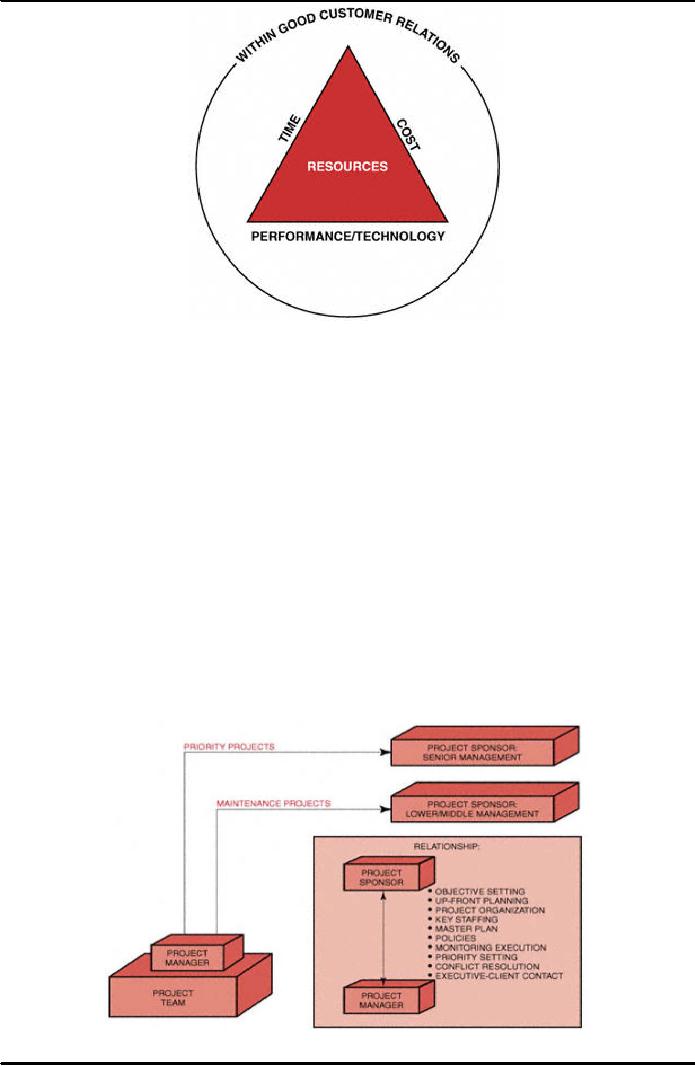
Project
Management MGMT627
VU
Figure
7.1: Overview of Project
Management
Success
in project management is like a
three-legged stool. The
first leg is the Project
Manager,
the
second leg is the line manager, and the
third leg is senior management. If
any of the three
legs
fail, then even delicate
balancing may not prevent
the stool from toppling
down.
The
critical node in project management is
the Project ManagerLine Manager
interface. At this
interface,
the project and line managers
must view each other as
equals and be willing to
share
authority,
responsibility, and accountability. In
excellently managed companies,
Project
Managers
do not negotiate for
resources but simply ask
for the line manager's
commitment to
executing
his portion of the work
within time, cost, and
performance. Therefore, in
excellent
companies,
it should not matter who the
line manager assigns as long
as the line manager
lives
up
to his commitments.
Since
the project and line managers
are "equals," senior management
involvement is necessary
to
provide advice and guidance to the
Project Manager, as well as to
provide encouragement to
the
line managers to keep their
promises. When executives act in
this capacity, they assume
the
role
of project sponsors, as shown in Figure
7.2 below, which also
shows that sponsorship
need
not
always be at the executive levels.
The exact person appointed as the
project sponsor is
based
on
the dollar value of the project, the
priority of the project, and who the
customer is.
Figure
7.2: The project sponsor
interface
59
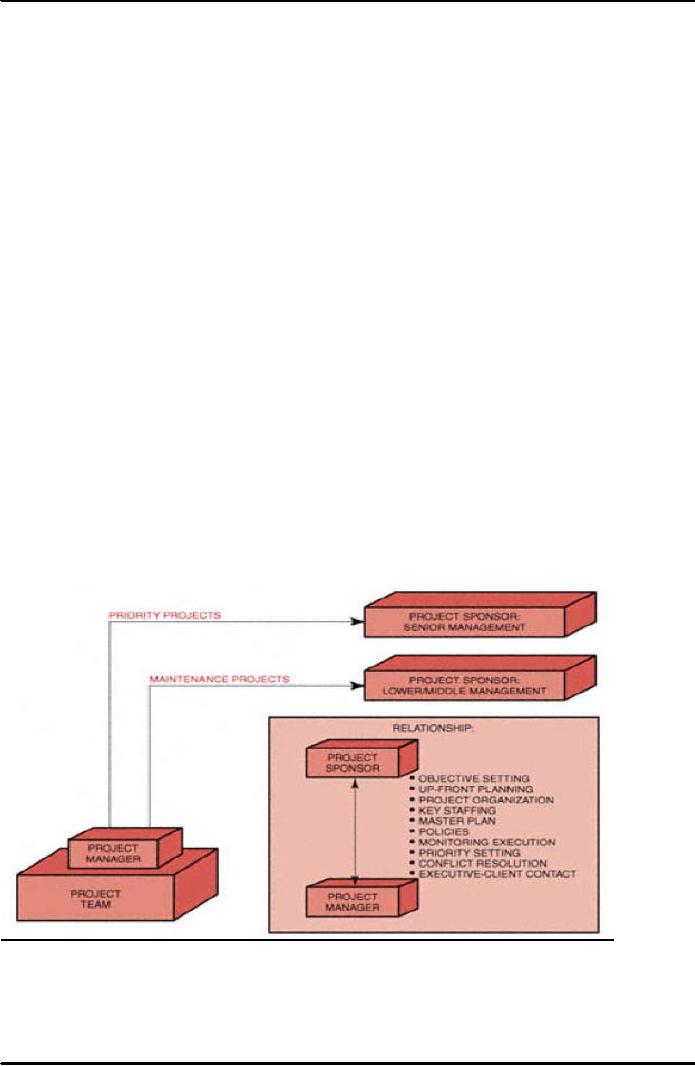
Project
Management MGMT627
VU
The
ultimate objective of the project
sponsor is to provide behind-the-scenes
assistance to
project
personnel for projects both "internal" to
the company, as well as "external," as
shown in
Figure
7.2 above.
Projects
can still be successful
without this commitment and support, as
long as all work
flows
smoothly.
But in time of crisis, having a
''big brother" available as a possible
sounding board
will
surely help.
When
an executive is required to act as a
project sponsor, then the executive
has the
responsibility
to make effective and timely
project decisions. To accomplish this, the
executive
needs
timely, accurate, and complete data
for such decisions. The
Project Manager must
be
made
to realize that keeping
management informed serves
this purpose, and that the
all-too-
common
practice of "stonewalling" will prevent
an executive from making
effective decisions
related
to the project.
The
line manager has to cope
with:
�
Unlimited
work requests (especially
during competitive
bidding)
�
Predetermined
deadlines
�
All
requests having a high
priority
�
Limited
number of resources
�
Limited
availability of resources
�
Unscheduled
changes in the project
plan
�
Unpredicted
lack of progress
�
Unplanned
absence of resources
�
Unplanned
breakdown of resources
�
Unplanned
loss of resources
�
Unplanned
turnover of personnel
Figure
7.3: Negotiating activities of System
Management
The
difficulty in staffing, especially
for Project Managers or Assistant
Project Managers, is in
determining
what questions to ask during an
interview to see if an individual
has the necessary
or
desired characteristics. There are
numerous situations in which
individuals are qualified to
be
promoted
vertically but not
horizontally. An individual with
poor communication skills
and
60
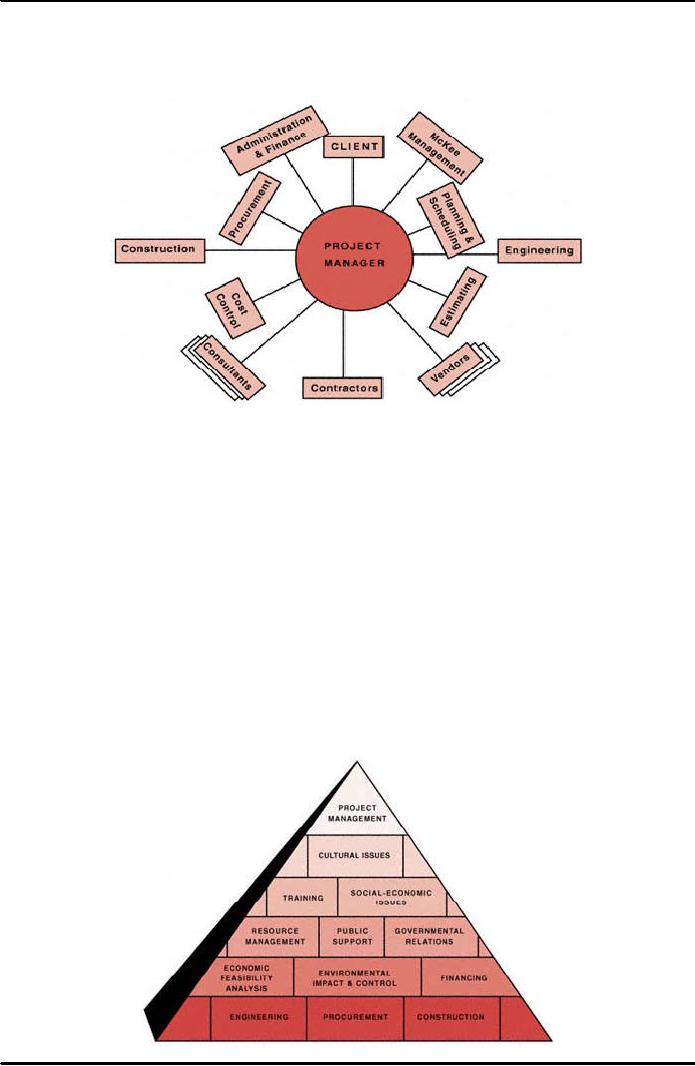
Project
Management MGMT627
VU
interpersonal
skills can be promoted to a
line management slot because
of his technical
expertise,
but this same individual is
not qualified for project
management promotion.
Figure
7.4: Managing the
Project
Most
executives have found that the best
way to interview is by reading
each element of the job
description
to the potential candidate. Many
individuals want a career
path in project
management
but are totally unaware of
what the Project Manager's duties
are.
So
far we have discussed the personal
characteristics of the Project Manager.
There are also
job
related
questions to consider, such
as:
�
Are
feasibility and economic analyses
necessary?
�
Is
complex technical expertise required? If
so, is it within the individual's
capabilities?
�
If
the individual is lacking expertise, will
there be sufficient backup strength in the
line
organizations?
�
Is
this the company's or the individual's
first exposure to this type of
project and/or client?
If
so,
what are the risks to be
considered?
�
What
is the priority for this
project, and what are the
risks?
�
With
whom must the Project
Manager interface, both
inside and outside the
organization?
61
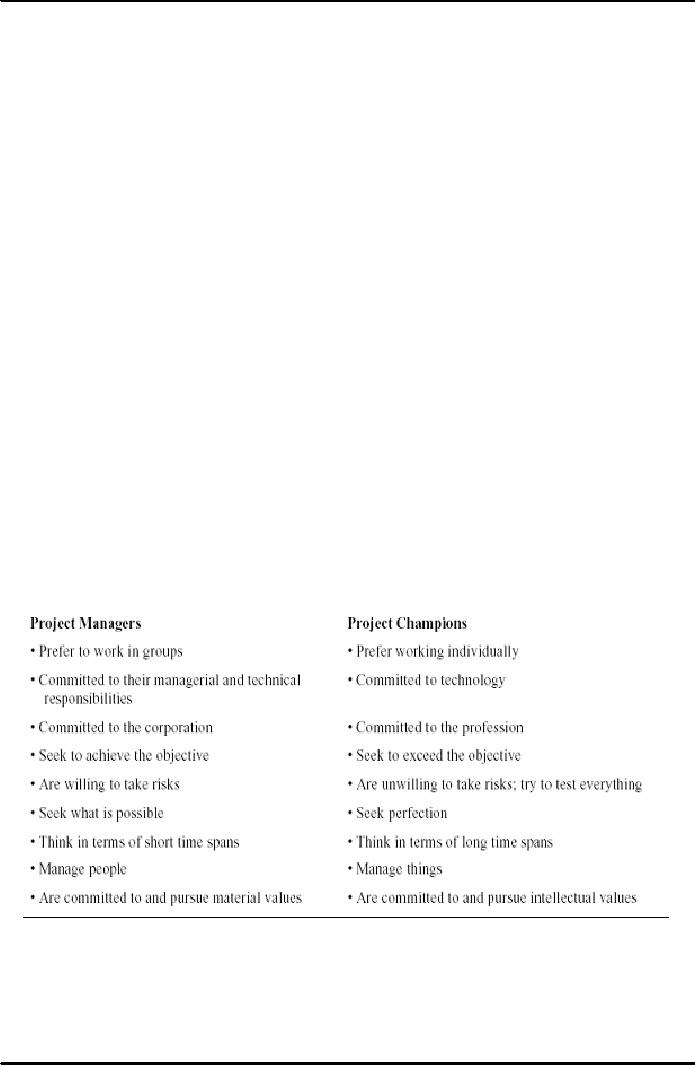
Project
Management MGMT627
VU
Figure
7.5: Project management
responsibilities
Most
good Project Managers
generally know how to
perform feasibility studies
and cost-benefit
analyses.
Sometimes this capability
can create organizational
conflict. A major utility
company
begins
each computer project with a
feasibility study in which a
cost-benefit analysis is
performed.
The
Project Managers, all of
whom report to a project
management division, perform the
study
themselves
without any direct
functional support. The
functional managers argue that the
results
are
grossly inaccurate because the functional
experts are not involved.
The Project Manager,
on
the
other hand, argues that they
never have sufficient time or
money to perform a complete
analysis.
There
are also good reasons
for recruiting from outside
the company. A new Project
Manager
hired
from the outside would be
less likely to have strong informal ties
to any one line
organization
and thus, could show impartiality on the
project. Some companies
further require
that
the individual spend an apprenticeship
period of twelve to eighteen
months in a line
organization
to find out how the company
functions, to become acquainted with
some of the
people,
and to understand the company's policies and
procedures.
One
of the most important but
often least understood characteristics of
good Project Managers is
their
ability
to understand and know both
themselves and their employees in terms
of strengths and
weaknesses.
7.4
Project
Champions:
Corporations
encourage employees to think up new
ideas that, if approved by the
corporation,
will
generate monetary and non-monetary
rewards for the idea
generator. One such reward
is to
identify
the individual as a "Project
Champion". Unfortunately,
all too often the
Project
Champion
becomes the Project Manager, and,
although the idea was
technically sounds, the
project
fails.
Table
7.1: Project Managers versus Project
Champions
7.5
Power
and Authority of Project
Manager:
One
form of the Project Manager's
authority can be defined as the
legal or rightful power
to
command,
act, or direct the activities of others.
The breakdown of the Project
Manager's
authority
is shown in Figure 7.6 below.
Authority can be delegated from
one's superiors. Power,
62
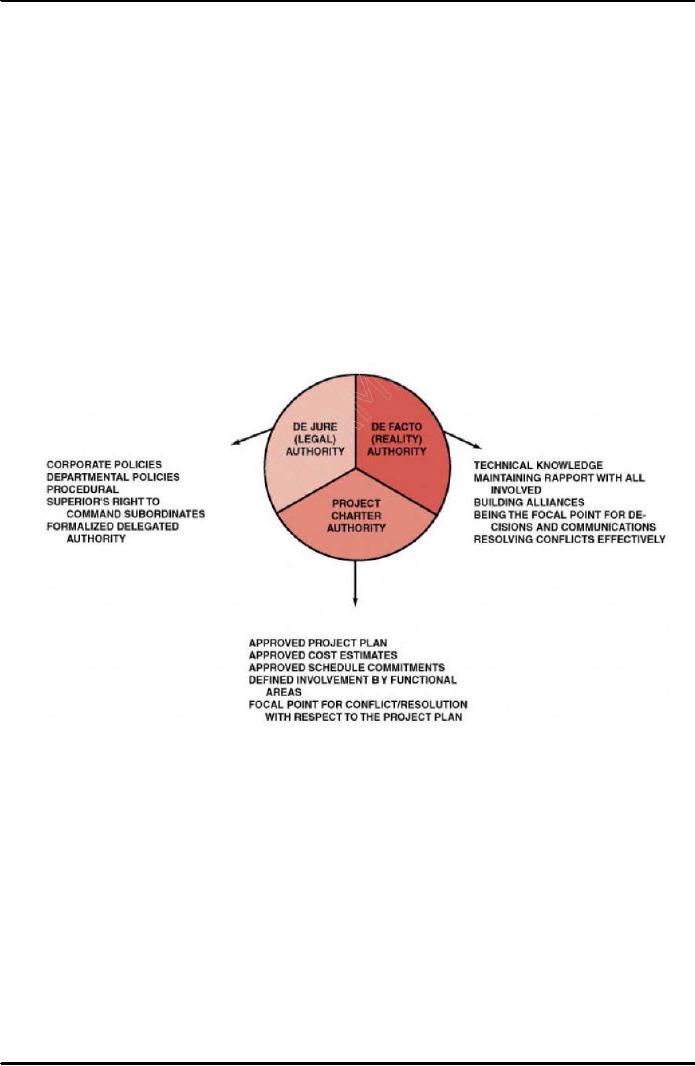
Project
Management MGMT627
VU
on
the other hand, is granted to an individual by his
subordinates and is a measure of
their
respect
for him. A manager's
authority is a combination of his
power and influence such
that
subordinates,
peers, and associates willingly
accept his judgment.
In
the traditional structure, the power
spectrum is realized through the
hierarchy, whereas in the
project
structure, power comes from
credibility, expertise, or being a sound
decision-maker.
Authority
is the key to the project management
process. The Project Manager
must manage
across
functional and organizational lines by
bringing together activities
required to accomplish
the
objectives of a specific project.
Project authority provides the
way of thinking required
to
unify
all organizational activities
toward accomplishment of the project
regardless of where
they
are located.
The
Project Manager who fails to
build and maintain his alliances
will soon find opposition
or
indifference
to his project requirements.
The
amount of authority granted to the Project
Manager varies according to project
size,
management
philosophy, and management interpretation
of potential conflicts with
functional
managers.
There do exist, however,
certain fundamental elements
over which the
Project
Manager
must have authority in order to
maintain effective
control.
Figure
7.6: Project Authority
Breakdown
Generally
speaking, a project manager
should have more authority than
his responsibility calls
for,
the exact amount of authority usually
depending on the amount of risk
that the Project
Manager
must take. The greater the
risk, the greater the amount of authority is. A
good Project
Manager
knows where his authority
ends and does not hold an
employee responsible for duties
that
he (the Project Manager)
does not have the authority to enforce.
Some projects are
directed
by
Project Managers who have
only monitoring authority.
These Project Managers are
referred
to
as influence Project
Managers.
Failure
to establish authority relationships can
result in:
�
Poor
communication channels
�
Misleading
information
�
Antagonism,
especially from the informal
organization
�
Poor
working relationships with superiors,
subordinates, peers, and
associates
�
Surprises
for the customer
63

Project
Management MGMT627
VU
The
following are the most common
sources of power and
authority problems in a project
environment:
�
Poorly
documented or no formal authority
�
Power and
authority perceived
incorrectly
�
Dual
accountability of personnel
�
Two
bosses (who often
disagree)
�
The
project organization encouraging
individualism
�
Subordinate
relations stronger than peer or
superior relationships
�
Shifting
of personnel loyalties from vertical to
horizontal lines
�
Group
decision making based on the
strongest group
�
Ability
to influence or administer rewards
and punishment
�
Sharing
resources among several projects
The
project management organizational
structure is an arena of continuous
conflict and
negotiation.
Although there are many
clearly defined authority boundaries
between functional
and
project management responsibilities, the
fact that each project
can be inherently
different
from
all others almost always
creates new areas where
authority negotiations are
necessary.
Certain
ground rules exist for
authority control through
negotiations.
Negotiations
should
take
place at the lowest level of
interaction.
Definition
of the problem must be the first
priority. This should
include:
�
The
issue
�
The
impact
�
The
alternative
�
The
recommendations
Higher-level
authority should be used if,
and only if, agreement cannot be
reached.
7.6
Functional
and Project Organizations:
Functional
organization is structure in which
authority rests with the
functional heads; the
structure
is sectioned by departmental groups.
7.6.1
Advantages
of Functional Structure:
�
Simple
and clear; coordination left to
top management
�
Reduces
overhead
�
Provides
clearly marked career paths
for hiring and
promotion
�
Employees
work alongside colleagues who
share similar
interests
7.6.2
Disadvantages
of Functional Structure:
�
Coordination
of functional tasks is difficult;
little reward for
cooperation with
other
groups
since authority resides with
functional supervisor.
�
Provides
scope for different department
heads to pass-off company project
failures
as
being due to the failures of other
departments.
7.6.3
Matrix
Organizations:
Most
organizations fall somewhere between the
fully functional and fully
projectized
organizational
structure. These are matrix
organizations.
Three points along
the
organizational
continuum have been
defined.
64

Project
Management MGMT627
VU
1.
Weak/Functional
Matrix:
A
Project Manager (often
called a project administrator
under this type of
organization)
with only limited authority
is assigned to oversee the
cross-
functional
aspects of the project. The
functional managers maintain
control over
their
resources and project areas.
The project administrator's
role is to enhance
communication
between functional managers and track
overall project
progress.
2.
Balanced/Functional
Matrix:
A
Project Manager is assigned to
oversee the project. Power is shared
equally
between
the Project Manager and the functional
managers. Proponents of this
structure
believe it strikes the correct balance, bringing
forth the best aspects
of
functional
and projectized organizations.
However, this is the most
difficult
system
to maintain as the sharing of power is a
very delicate proposition.
This
is
also the most complex
organizational structure to
maintain.
3.
Strong/Project
Matrix:
A
Project Manager is primarily responsible
for the project.
Functional
managers
provide technical expertise and assign
resources on an as-needed
basis.
Because project resources
are assigned as necessary, there
can be
conflicts
between the Project Manager and the
functional manager
over
resource
assignment. The functional
manager has to staff
multiple projects with
the
same experts.
4.
Soft
boundaries Matrix:
A
fourth organization type is the
"soft boundaries matrix". In this the
functional
team
members provide technical expertise
and assign resources on an
as-needed
basis.
Because project resources
are assigned as necessary there is no
need for
Project
Managers or a functional manager
over resource
assignment.
65
Table of Contents:
- INTRODUCTION TO PROJECT MANAGEMENT:Broad Contents, Functions of Management
- CONCEPTS, DEFINITIONS AND NATURE OF PROJECTS:Why Projects are initiated?, Project Participants
- CONCEPTS OF PROJECT MANAGEMENT:THE PROJECT MANAGEMENT SYSTEM, Managerial Skills
- PROJECT MANAGEMENT METHODOLOGIES AND ORGANIZATIONAL STRUCTURES:Systems, Programs, and Projects
- PROJECT LIFE CYCLES:Conceptual Phase, Implementation Phase, Engineering Project
- THE PROJECT MANAGER:Team Building Skills, Conflict Resolution Skills, Organizing
- THE PROJECT MANAGER (CONTD.):Project Champions, Project Authority Breakdown
- PROJECT CONCEPTION AND PROJECT FEASIBILITY:Feasibility Analysis
- PROJECT FEASIBILITY (CONTD.):Scope of Feasibility Analysis, Project Impacts
- PROJECT FEASIBILITY (CONTD.):Operations and Production, Sales and Marketing
- PROJECT SELECTION:Modeling, The Operating Necessity, The Competitive Necessity
- PROJECT SELECTION (CONTD.):Payback Period, Internal Rate of Return (IRR)
- PROJECT PROPOSAL:Preparation for Future Proposal, Proposal Effort
- PROJECT PROPOSAL (CONTD.):Background on the Opportunity, Costs, Resources Required
- PROJECT PLANNING:Planning of Execution, Operations, Installation and Use
- PROJECT PLANNING (CONTD.):Outside Clients, Quality Control Planning
- PROJECT PLANNING (CONTD.):Elements of a Project Plan, Potential Problems
- PROJECT PLANNING (CONTD.):Sorting Out Project, Project Mission, Categories of Planning
- PROJECT PLANNING (CONTD.):Identifying Strategic Project Variables, Competitive Resources
- PROJECT PLANNING (CONTD.):Responsibilities of Key Players, Line manager will define
- PROJECT PLANNING (CONTD.):The Statement of Work (Sow)
- WORK BREAKDOWN STRUCTURE:Characteristics of Work Package
- WORK BREAKDOWN STRUCTURE:Why Do Plans Fail?
- SCHEDULES AND CHARTS:Master Production Scheduling, Program Plan
- TOTAL PROJECT PLANNING:Management Control, Project Fast-Tracking
- PROJECT SCOPE MANAGEMENT:Why is Scope Important?, Scope Management Plan
- PROJECT SCOPE MANAGEMENT:Project Scope Definition, Scope Change Control
- NETWORK SCHEDULING TECHNIQUES:Historical Evolution of Networks, Dummy Activities
- NETWORK SCHEDULING TECHNIQUES:Slack Time Calculation, Network Re-planning
- NETWORK SCHEDULING TECHNIQUES:Total PERT/CPM Planning, PERT/CPM Problem Areas
- PRICING AND ESTIMATION:GLOBAL PRICING STRATEGIES, TYPES OF ESTIMATES
- PRICING AND ESTIMATION (CONTD.):LABOR DISTRIBUTIONS, OVERHEAD RATES
- PRICING AND ESTIMATION (CONTD.):MATERIALS/SUPPORT COSTS, PRICING OUT THE WORK
- QUALITY IN PROJECT MANAGEMENT:Value-Based Perspective, Customer-Driven Quality
- QUALITY IN PROJECT MANAGEMENT (CONTD.):Total Quality Management
- PRINCIPLES OF TOTAL QUALITY:EMPOWERMENT, COST OF QUALITY
- CUSTOMER FOCUSED PROJECT MANAGEMENT:Threshold Attributes
- QUALITY IMPROVEMENT TOOLS:Data Tables, Identify the problem, Random method
- PROJECT EFFECTIVENESS THROUGH ENHANCED PRODUCTIVITY:Messages of Productivity, Productivity Improvement
- COST MANAGEMENT AND CONTROL IN PROJECTS:Project benefits, Understanding Control
- COST MANAGEMENT AND CONTROL IN PROJECTS:Variance, Depreciation
- PROJECT MANAGEMENT THROUGH LEADERSHIP:The Tasks of Leadership, The Job of a Leader
- COMMUNICATION IN THE PROJECT MANAGEMENT:Cost of Correspondence, CHANNEL
- PROJECT RISK MANAGEMENT:Components of Risk, Categories of Risk, Risk Planning
- PROJECT PROCUREMENT, CONTRACT MANAGEMENT, AND ETHICS IN PROJECT MANAGEMENT:Procurement Cycles